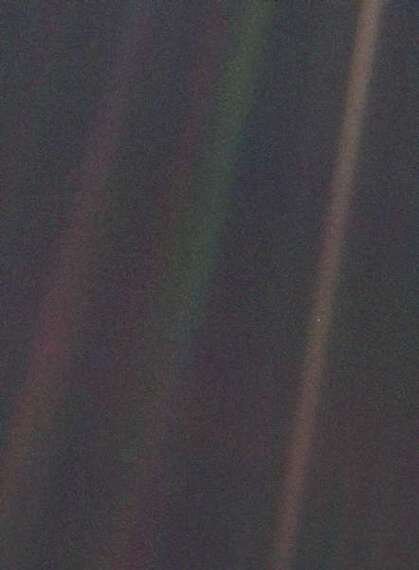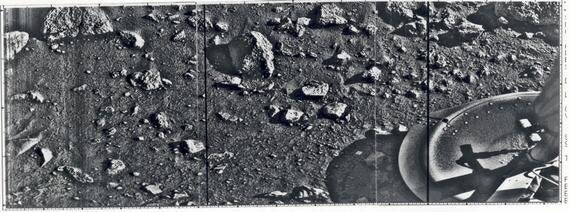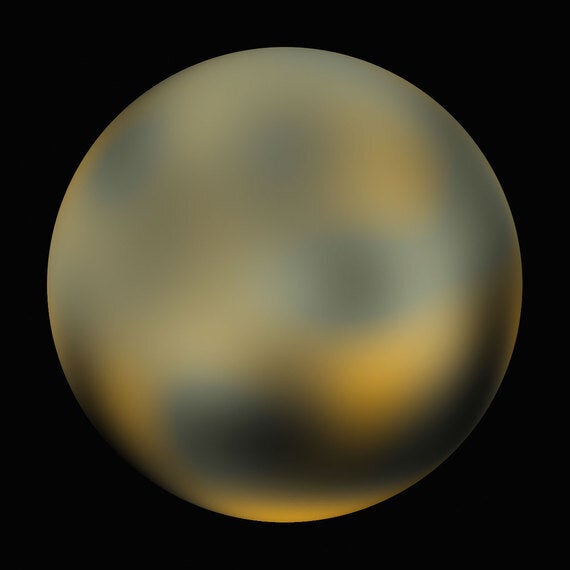Peering into space with telescopes provides us with some of the most spectacular images in existence. From the towering columns of gas and dust that hide the birthplace of stars, to the vast swirls of countless stars in spiral galaxies, astronomical photographs rightly adorn walls and computer backgrounds worldwide.
But sometimes astronomers release images that most people wouldn't look at twice. This saddens me because the science behind these images is usually mind-blowing. So with that in mind, here are my top five unimpressive images from space, and why they're actually amazing.
1. Pale Blue Dot - Voyager mission

Image from Visible Earth, NASA
Take a close look at this picture. Specifically the brown stripe on the righthand side. That tiny pale blue-white speck halfway down this stripe is planet Earth. Stop for a moment to take that in. Famous astronomer Carl Sagan summed up perfectly why this image is so incredible:
Look again at that dot. That's here. That's home. That's us. On it everyone you love, everyone you know, everyone you ever heard of, every human being who ever was, lived out their lives...on a mote of dust suspended in a sunbeam.
-Carl Sagan, Pale Blue Dot: a Vision of the Human Future in Space
This picture was taken in 1990 by the Voyager 1 spacecraft when it was over four billion miles away from Earth. Voyager 1 is still going and recently left the Sun's protective magnetic bubble, making it humankind's first interstellar spacecraft.
2. Hubble Deep Field

Image from Robert Williams and the Hubble Deep Field Team (STScI) and NASA/ESA
This might be controversial but I don't think the Hubble Deep Field looks great. After all, it's just a collection of mostly orange or blue fuzzy blobs on a black background. But this is one of the most famous images taken by the Hubble Space Telescope, and rightly so.
Nearly every one of those fuzzy blobs is in fact a huge galaxy, each one containing hundreds of billions of stars. The Hubble Deep Field contains over 1,500 galaxies in a tiny patch of sky that would be covered up by a grain of sand held at arm's length. Using this image we can estimate that there are over 100billion galaxies in the observable Universe, meaning that our Sun is just one of at least 10,000,000,000,000,000,000,000 stars out there!
3. Beta Pictoris b

This pixelated picture from the Gemini South telescope definitely looks unimpressive but what it shows is incredible. The bright spot to the lower right is a planet, but it's not in our solar system. Instead this planet orbits around a distant star 63 lightyears (370 thousand billion miles) away from us.
Astronomers have found nearly 2,000 exoplanets (planets orbiting other stars) so far but most of these have been found indirectly by looking at the effect they have on their 'parent' star. Taking direct images of them is really hard because the star is so bright - in this picture the central star has been blocked out, letting the telescope pick up the much fainter light reflecting off the planet. Directly observing exoplanets allows us to work out what their atmospheres are made of, bringing us one step closer to finding exoplanets that could sustain life.
4. Martian Surface - Viking 1

Image Credit: NASA
At first glance, this just looks like a grainy old photograph of rocks in the desert. I guess that's technically true, but what makes this image amazing is that this desert is on another world.
This is the first picture taken of the surface of Mars, from the surface of Mars itself. It was captured in 1976 by the Viking 1 lander (one of its feet can be seen in the bottom right), which was sent to find out more about Mars, and in particular look for signs of life. The results were inconclusive so we are still looking nearly 40 years later, but our search may soon be over. In 2018 the European Space Agency will launch the British-built ExoMars rover, which they hope will finally answer the question of whether there is (or has ever been) life on Mars.
5. Pluto

This blurry picture is one of the best photographs we currently have of Pluto, formerly the furthest planet in our solar system (Pluto was demoted to a dwarf planet in 2006, meaning that Neptune is now the furthest planet). Taken by the Hubble Space Telescope, no detail can be seen on the surface, just dark and light areas.
I've included this image because I'm excited that soon this won't be our best picture of Pluto. After spending the last nine years travelling out from Earth, the New Horizons spacecraft is closing in on Pluto and will be flying past the dwarf planet in July of this year. Soon we'll have much more detailed photographs of this small rocky world and for the first time we'll really know what it looks like!
Dr Jen Gupta is an astrophysicist and science communicator; she is currently based in the Institute of Cosmology and Gravitation at the University of Portsmouth where she is the South East Physics Network/Ogden Outreach Officer. She also occasionally works at the Winchester Science Centre as a planetarium presenter and helps to organise the Winchester Science Festival.
Jen has been shortlisted in the Young Achiever category for this year's Asian Women of Achievement Award for her work engaging with the next generation of British scientists.